Last month at F8 Facebook delivered a presentation on their News Feed and how they determine what content ranks where.
You can see the whole thing here:
For many marketers there’s unlikely to have been a whole lot of new, revolutionary information in that presentation. We already knew that your relationship with the author of the content is a key factor as is the content type and the engagement rate for determining where content ranks in the News Feed. And for those that also follow Facebook’s News Feed blog, you’ll have already been aware of the algorithm updates that they have rolled out recently. Nonetheless, there was still a lot in there that, if you look a little deeper, seemed to be quite significant.
Before I start, let me acknowledge that what I am doing is analysing Facebook’s hypothetical example so there is the possibility that this is just another instance of a marketer over-analysing and obsessing over the platform. However, the aim is to try and provide something more tangible about what influences where your content ranks in News Feed.
For those that haven’t watched the video yet, “at a high level there are three major buckets” that are considered when ranking content in News Feed.
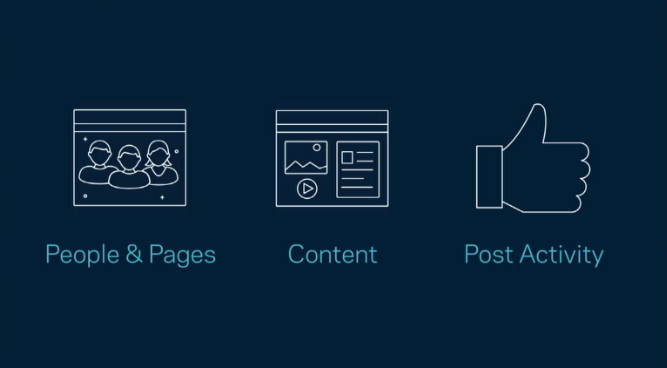
- People & Pages - your relationship with the author of the content
- Content - the type of content a post is and whether we engage with this type of content more or less than other types
- Post Activity - the engagement that a piece of content has received. Do lots of other people like this content too?
Based on the combination of the above, News Feed will then allocate a ‘Relevance Score’ to each piece of content, and since it is based on your relationship with the author and your content type preferences, it is completely unique to you. Of course there are likely to be hundreds if not thousands of tiny factors that will form the overall Relevance Score, but this is a very good way of simplifying how to think about it.
Facebook’s Product Management Director, Adam Mosseri, then goes on to look at a hypothetical situation within News Feed to further explain how each piece of content is ranked. You can see this below.
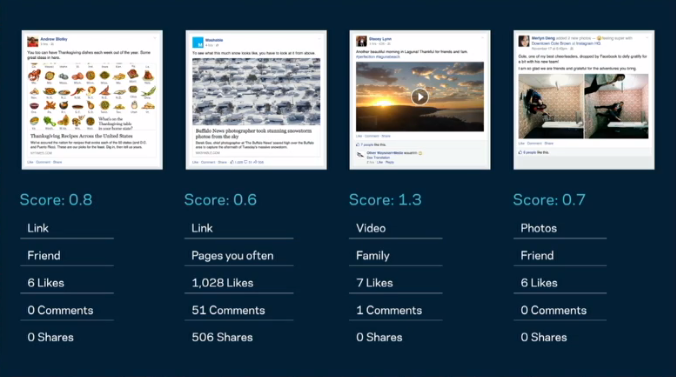
What you can see is four pieces of content from a combination of friends, family and pages that could all very reasonably appear in your own News Feed and would all be ranked according on their score (the higher the better).
Again, it is a hypothetical example, but I think there are a few things here that provide a very important insight into how you should approach your marketing strategy on Facebook. This leads me on to my first assumption…
Assumption 1 - Reflecting Reality
Whilst the example given is, as stated in the presentation, a hypothetical situation you would assume that it would nonetheless reflect reality as closely as possible. Presumably Facebook wouldn’t create an example with clear flaws in it in a key presentation at one of their biggest conferences.
If we assume the above to be true, we can then start to do a bit of analysis on those four pieces of content to come to some relatively important conclusions.
Let’s take another example. Examine the first two posts below:
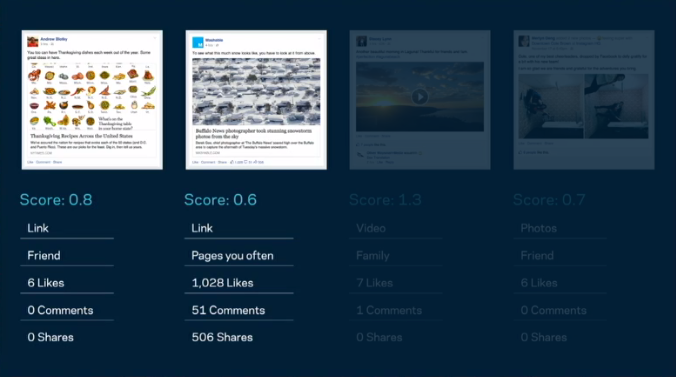
What can we see? Well...
- The content type is the same so these must naturally cancel each other when influencing the ranking score
- The first post is by a friend, while the second is by a page
- The second example has significantly higher engagement, however the first has a higher Relevance Score
This seems to suggest quite clearly that ‘People & Pages’ (i.e. your relationship with the author) is considered as significantly more important than Post Activity when deciding the eventual score.
That seems to make sense. Just because lots of other people like a piece of content doesn’t mean that you will like it whereas if you frequently engage with the content from the same author, that entails that you are interested in what they have to say, regardless of who else is.
Now, if we compare the first and the last example…
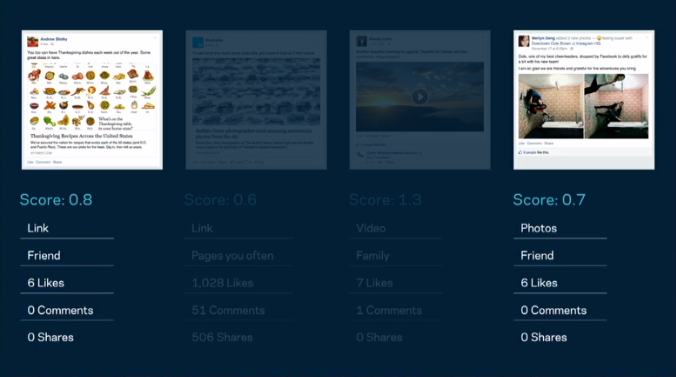
- The Content Type is different for both
- The Author is different for both
- The Post Activity is the same (maybe)
Assumption 2 - The Same for a Reason
I say maybe because another type of engagement - clicks - is missing from the above and could in theory influence why the left one ranks higher, though you would assume that the two have been allocated the same engagements for the purpose of highlighting the importance of something else.
Assuming that is the case, this leaves us with either Content or People & Places as the key factor. Starting to see a trend?
Another one...
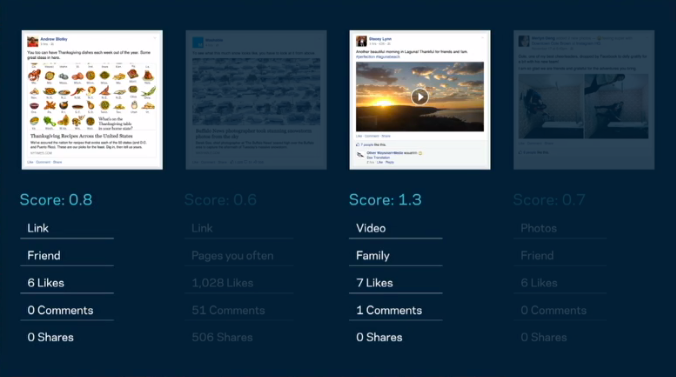
What do we notice from this?
- Content type is different
- Author type is different
- Engagement is different (though only very slightly).
Assumption 3 - You can choose your family
Whilst there is nothing here that can definitively prove it either way, I think the curious part seems to be the clear use of ‘Family’ as an example of an author type and coincidence that this has (in context of the other 3) a substantially higher score. Of course, Family is a term that is used by Facebook anyway, you can set who your family members are and by what relation. However, despite this you would assume that your engagement history with that person is still what decides if they rank in your News Feed and not simply because they are a relative. For example, how many people really want to see their parent’s awkward attempts at updating their Facebook with news that the family dog has received a walk today? What I’m suggesting is that the use of ‘Family’ as a term in the presentation is to represent a deeper engagement history and content interaction and not that Family = automatically high relevance score. In fact, this seems to be suggested by Mosseri when he touches upon this in his own example earlier on in the presentation with regard to his own sister (around 7 mins in). Therefore, going back to the examples, if the term “Family” is to represent the deeper engagement history and the score is significantly higher, then again it looks like the single most important factor to influence where you rank in News Feed is your relationship with the author.
Again, logically that seems to make sense. At it’s core Facebook has always been about people connecting with people and therefore relationships. Elements such as content type came after this and so it only makes sense that the algorithms should also reflect this.
So, as marketers, what conclusions can we draw?
Relationships Really Matter
If the relationship between the author and the end user is the primary factor in influencing distribution on Facebook then ultimately the goal for marketers is not about one off interactions, but around ensuring their audience is regularly and repeatedly engaging with the content that you post.
That may sound basic and to a large degree it is. In truth it is just another iteration of ‘quality over quantity’ or ‘content is king’ but even so there are still far too many page managers and marketers who nod along when they hear this and then focus their attention on Facebook metrics that don’t matter. The goal is not distribution, that is a by product of the true goal: forging strong relationships with your audience.
Stay Updated with Our Latest Insights
Get expert HubSpot tips and integration strategies delivered to your inbox.



